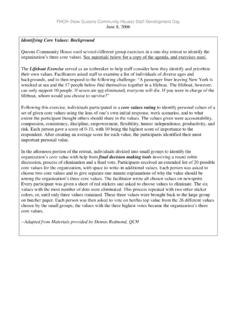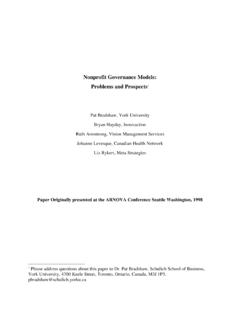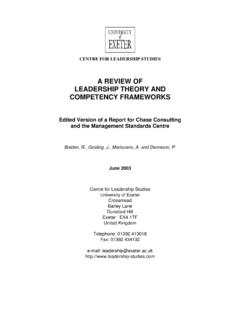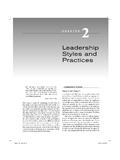Transcription of Leadership - Building Movement Project
1 Generations series Structuring Leadership : Alternative Models for Distributing Power and Decision-Making in Nonprofit Organizations by Car oline M cAndrews F r an ces K unreuther Sh ifr a Bronzni ck BU I L D ING Movement P ROJECT. The goal of the Building Movement Project is to build a strong social justice ethos into the nonprofit sector, strengthen the role of nonprofit organizations in the United States as sites of democratic practice, and promote nonprofit groups as partners in Building a Movement for progressive social change. To accomplish its goals, the Building Movement Project makes use of four core strategies: Changing the discourse and practice within the nonprofit sector to endorse social change and social justice values. Identifying and working with social service organizations as sites for social change activities in which staff and constituencies can be engaged to participate in Movement Building . Supporting young leaders who bring new ideas and energy to social change work.
2 Listening to and engaging people who work in social change organizations especially grassroots and community-based groups to strengthen their ability to shape the policies that affect their work and the communities they serve. A B O U T THE AU TH ORS. Caroline McAndrews is the Director of Leadership & Communications for the Building Movement Project , which she joined in 2004. She directs the Project 's work on generational changes in Leadership in addition to coordinating BMP communications, and is the author of What Works: Developing Successful Multigenerational Leadership . Prior to Building Movement , Caroline was a member of the economic security team at the Ms. Foundation for Women, where she provided funding, technical assistance, and networking opportunities to nonprofits across the country working with women to start small businesses, organize for workers' rights, and develop Leadership in labor unions. Before working at Ms., she served as the IDA Program Coordinator for Mid-Peninsula Housing Coalition, a low- income housing developer in Redwood City, California.
3 Frances Kunreuther directs the Building Movement Project , which works to strengthen nonprofits as sites of civic engagement and social change. She is co-author of From the Ground Up: Grassroots Organizations Making Social Change (Cornell, 2006) and Working Across Generations: Defining the Future of Nonprofit Leadership (Jossey Bass, 2008). Frances is also a senior fellow at the Research Center for Leadership and Action at New York University and spent five years at the Hauser Center for Nonprofit Organizations at Harvard University. She headed the Hetrick- Martin Institute for LBGT youth, and was awarded a year-long Annie E. Casey Foundation fellowship in 1997 for this and her previous work. Over the years, Frances has worked with homeless youth and families, undocumented immigrants, crime victims, battered women, and substance users. She is a writer and presenter on variety issues related to nonprofits, Leadership , and social change. Shifra Bronznick is a consultant to social change organizations.
4 The President of Advancing Women Professionals and the Jewish Community, she is the co-author with Didi Goldenhar and Marty Linsky of the book, Leveling the Playing Field. Shifra is the key investigator of Visioning Justice, an action research Project commissioned by the Nathan Cummings Foundation to strengthen the field of Jewish social justice. A senior fellow at the NYU Research Center for Leadership in Action at the Wagner Graduate School of Public Service, she teaches strategic Leadership in their Executive Masters in Public Administration program. Introduction For the past ten years the Building Movement Project has addressed Leadership in the nonprofit sector by focusing on generational shifts, multigenerational Leadership and new ways of leading. In each of these areas, the question we are most often asked by younger generations is whether we can provide them with new models of how to run/lead organizations that do not concentrate authority and responsibility in one top person.
5 We believe these models exist but they are either unrecognized or embedded within traditional- looking hierarchies. We also believe that highlighting different Leadership structures will offer organizations examples for effective ways to operate that can increase impact. We set out to identify and document these models and while we did find some key examples, we did not find as many as we hoped. Innovation was more likely in smaller organizations where experimental structures are often easier to put into operation because bureaucracy and culture can be less entrenched or easier to adapt when fewer people are involved. In larger organizations ( more than 10 staff members), alternative models were more difficult to find, and in some cases, they were strongly linked to the current leader, not to a structure that would last as different individuals moved into Leadership positions. Most research on Leadership structures has been focused on the for-profit sector, where corporations have been experimenting with new models in an attempt to increase their productivity and competitiveness in a global In the nonprofit sector, recent reports have pointed to the need to look at how Leadership is One particular nonprofit model we were repeatedly pointed towards to look for innovative Leadership structures was the field of social entrepreneurship in which new ideas drive fast growth, innovation, and replication.
6 These groups often excelled in Leadership development, but Leadership models often centered around a founder with an idea, rather than a collaborative or alternative model of operation. Social enterprises are very closely modeled after for-profit start-up ventures, in a similar way to many of the nonprofits started in the 1960's that were modeled after small corporations of the day. To find other nonprofit examples, we developed an interview protocol that we vetted with Leadership development consultants and others working with nonprofit organizations. Based on their responses and insights, we conducted an online survey that was completed by 112 organizations of varying size across the The survey focused on organizational decision making as a way to identify alternative structures . We used the survey results, along with recommendations from partners in the field to interview a small group of organizations that were identified as having different structures.
7 The interviews concentrated on decision- making practices, the role of Leadership , and organizational structure, paying special attention to issues of age, race, gender, and class. These interviews, usually with one of the organization's key leaders, focused on how major decisions were made; the role of non-executive Leadership , including independent goal-setting and control over work, budget, and program decisions; and the role of the board. We paid special attention to organizations with more than 10 staff members in order to find models that worked at larger scales. The findings below detail what we found, along with 3 case examples and a final list of questions we will continue to explore. Structuring Leadership 1. Findings While there were only a few organizations that met our initial criteria as having alternative operating models in our online survey and subsequent interviews, there emerged a typography of different decision-making structures that had developed as a pragmatic way to respond to the demands of their mission and to increase their impact.
8 We categorized these findings by stressing two different practices. Shared Leadership describes a model in which the top level of executive Leadership is shared internally by two or more people (for example, a co-directorship). Distributed Leadership is a model in which there is one person in the executive role, but decision-making is consistently and methodically pushed down to other levels in the organization (for example, strong program directors). Each model had elements in common, and some groups operated in a way where Leadership was both shared and distributed (for example, a Project -based structure). Across these models, there were certain key principles that we identified as indicative of distributed or shared Leadership , even in those groups that appear to be traditionally hierarchical. Below, we present our findings by first exploring the foundations upon which to build distributed or shared Leadership models. We then describe how to implement shared Leadership practices, and finally we present indicators of the effectiveness of those practices.
9 We end the paper with three case examples. Foundations for Distributed Leadership We investigated several different models of Leadership , including strong senior management teams, independent Project Leadership , two or more co-directors, and constituent or client-led decision-making structures. Several themes arose which indicated that certain elements must be in place for alternative models to work, in order to move Leadership out of the realm of the executive and to form the basis for strong systems of decision-making. High levels of trust: Every person we interviewed brought up the issue of trust. Strong trust came up in two ways as both necessary to operating within a distributive Leadership structure, but also as a result of operating that way. In other words, the process of trusting people to make good decisions leads to further increased trust in the organization. This involves a high level of transparency as well, including around money and budgets which is not always a norm in nonprofit organizations.
10 Investment in learning: Each of our respondents pointed to the importance of investing resources in the learning and development of all staff in order to equip them to make informed decisions individually and to contribute to shared decision-making. While this might include Leadership training and learning about the history of an issue, the mission and vision of both the organization and individual projects were also important. As one director put it, Decision-makers need a high degree of information, and we need to have the people implementing programs involved, not others. All decision-makers have expertise and responsibilities. This came into play in vetting new hires as well. 2 Structuring Leadership Values are important: Almost all of our respondents spoke of the importance of not only values-based Leadership , but also to the importance of Building a structure that supports organizational values. Groups value sharing diverse ideas and opinions and including stakeholders and constituents.










